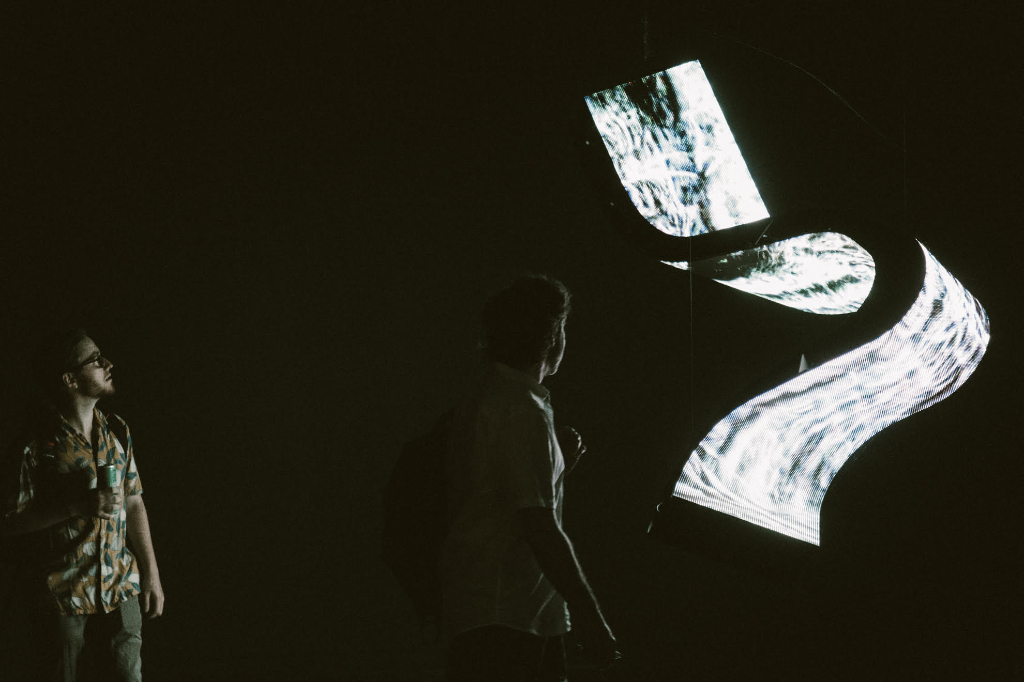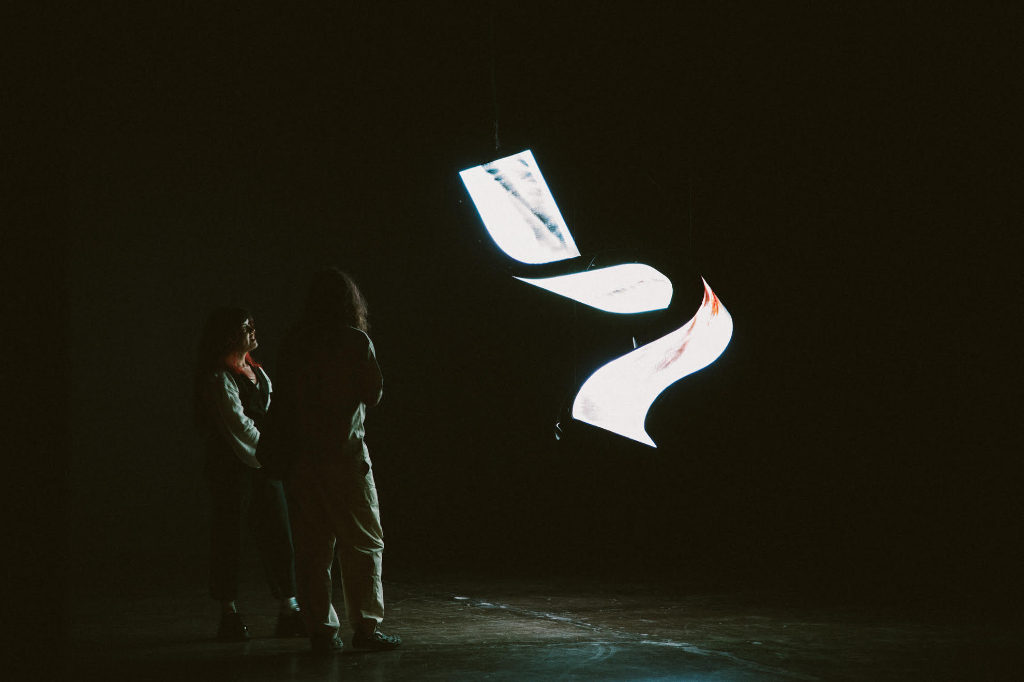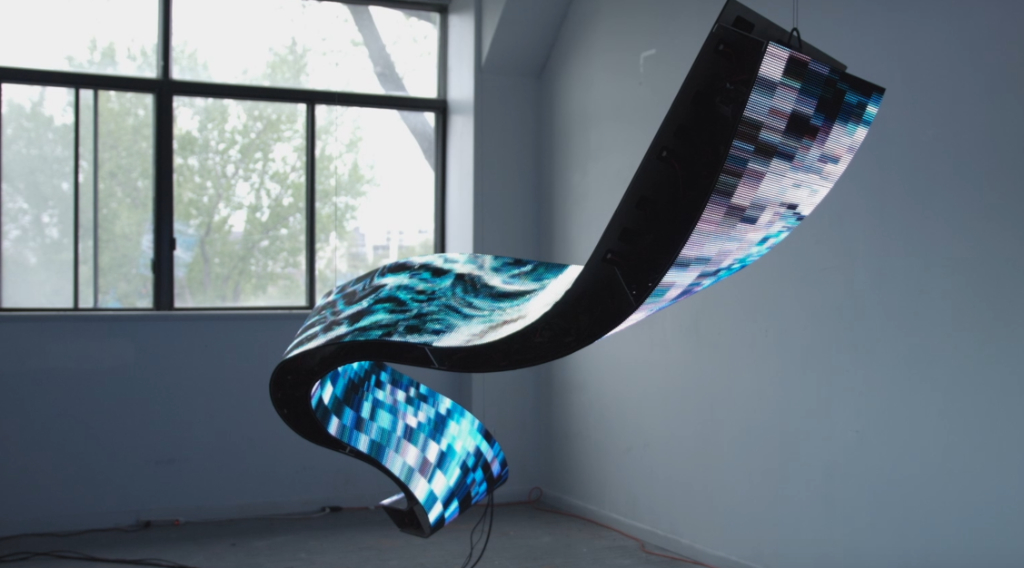Text by Ed Harrington

Hidden Edge‘s installation Chasing Waterfalls, winner of the Edigma Semibreve Award 2024, questions and explores the duality and hierarchy between our virtual and physical existence in the face of the fast dematerialisation of information and advancement of machine learning. Displaying a twisted screen structure that resembles a flowing yet suspended waterfall, the piece’s fractal mechanic sounds form with the actions of the animations, flowing like water and then distorting into pixelated patterns.
Lucas Paris and Myriam Bleau expressed their thoughts about the intention of the piece, in particular, this duality between virtual and physical, materialised and dematerialised. In ‘Chasing Waterfalls’ and in general in our practice, we try to question these dualities – physical/virtual, body/mind – that have tangible socio-political and environmental consequences. While the materiality of 2D screens is meant to be forgotten in favour of the information that they convey – acting like transparent wormholes to the virtual world – our twisted structure exists steadfastly in the physical world and doesn’t let you forget its materiality.
Another observation reflected upon in the installation is the history of the digital image itself as a progression from a pixelated, squarish and quantised depiction to a hyper-smooth, realistic and immersive version and how this affects our perceptions. In a way, the sculpture proposes an exercise in simulation and simulacra. The curve of the structure evokes the shape of a cascading stream while the video content depicts artificially recreated water waves, pointing towards the dizzying accumulation of images online and endless copies of those images, leaving us unsure about what is real. Along with the hyperconnected nature of our social interactions, these organic digital visualisations question the duality and the hierarchy between the virtual and the physical world. Is the physical world more ‘real’ than the virtual one? Both worlds become blurred and affect each other in subtly entangled ways.
The artwork is less interested in the suggestion of machine learning being a separate entity that goes beyond an extension of our intelligence but more in how we are interconnected with this technology in a capitalist world that is developing it unethically and the dangers of its existence in relation to our information and livelihood. The current landscape of machine learning is based on plundered data from mostly unwilling or unaware participants and is used widely as a tool for power and control. If AI is a separate entity from us, it still needs to be fed, and how we choose to feed it raises many ethical and political questions. Rather than splitting hairs about how to correct its biases or censor its output towards political correctness, we are more interested in questioning its very existence, as it’s inherently a parasitical technology. Hidden Edges explained.

The anamorphic effects used within the structure conceal and reveal meaning within the piece, playing a significant role in linking it to its title. You can’t see the entire structure at once; it escapes the single-channel mentality of a cartesian plane. Anamorphosis was also a common technique in Baroque painting. The most striking example is perhaps the anamorphic skull in the foreground of the painting The Ambassadors by Hans Holbein. The distorted skull seems to deliver a secret hidden message associated with the idea of death and the vanity of human endeavours, which resonates with the title of our work.
As a generative installation, it is constantly evolving subtly. The sound intertwines with and triggers elements of the visuals. Composed algorithmically in Supercollider, the sounds use additive synthesis and granulation, and these generated patterns affect the visual manipulations of the flowing water images in Touchdesigner. Elements stay in the background while others stand out in the foreground, disturbing the surface. We created this soundscape to feel both close and intimate but also distant and reverberating, like the rumbling of a small waterfall in the forest. From past presentations of the installation, a contemplative quality emerges for viewers, as they can switch their focus from the details of the waves to the more continuous flow of the sustained elements. Perhaps it’s less an active state that triggers interaction but a meditative one that invites reflection. They shared over Email.
The piece, on the whole, questions the actual purpose of emerging AI and its capabilities and how much it benefits our quality of life. Pointing out the contrast between our initial innocence and optimism surrounding machine learning to our recent reservations and scepticism concerning its path, Hidden Edges express that their art confronts how current capitalised machine learning uses individuals’ information and content without their consent, sucking away creativity and community, and blurring the line between authenticity and artificiality. Predictive models for supposedly better-curated recommendations don’t add value for users and become capitalist tools for control, while the big platforms are slowly killing community-based resources for accessing specialised information. AI-generated content will probably be indifferent to human-made material in a couple of years, except perhaps in its originality or tone. However, as companies are slowly putting us to sleep with the same viral videos that replace our culture and news feeds, we wonder if we will be equipped to see the difference.
Chasing Waterfalls will be on display from 24 to 28 October. Find tickets here.






